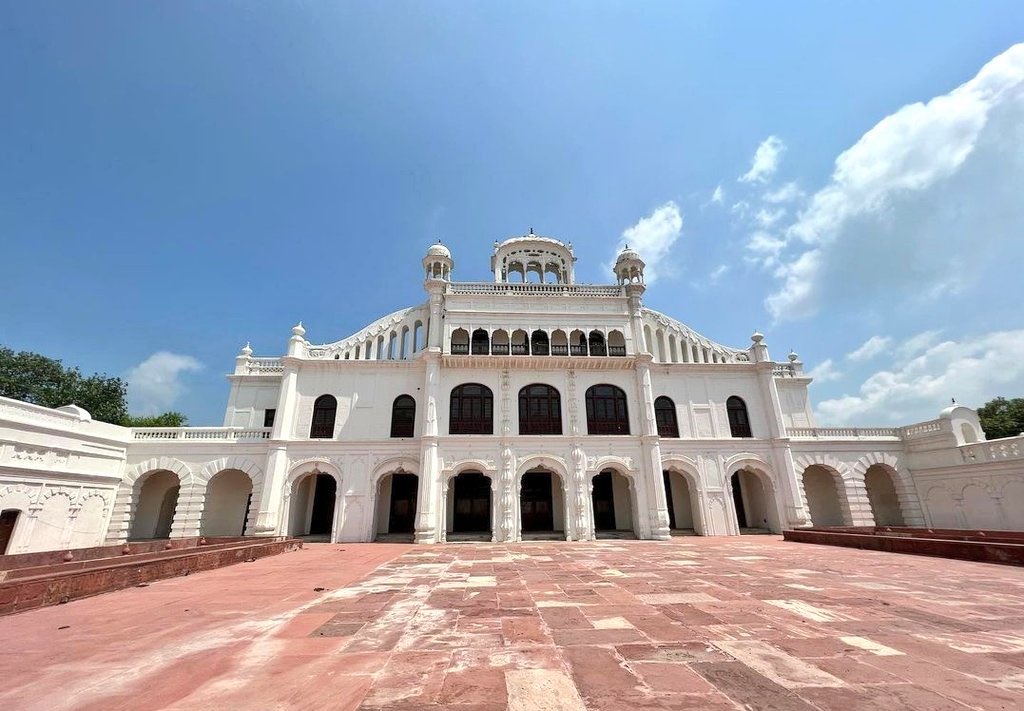#Thread on
#SarbatKhalsa #ਸਰਬੱਤ_ਖ਼ਾਲਸਾ
meaning of 👏🏻“Sarbat Khalsa👏🏻
“is (All The Khalsa)
it literally Translates to The entire Sikh Population
The first Sarbat Khalsa was called by the 10th Sikh guru,#GuruGobindSingh before his death in 1708
#Vaisakhi #Punjab
#SarbatKhalsa #ਸਰਬੱਤ_ਖ਼ਾਲਸਾ
meaning of 👏🏻“Sarbat Khalsa👏🏻
“is (All The Khalsa)
it literally Translates to The entire Sikh Population
The first Sarbat Khalsa was called by the 10th Sikh guru,#GuruGobindSingh before his death in 1708
#Vaisakhi #Punjab

The first Sarbat Khalsa was called by the tenth guru, #GuruGobindSingh before his death in 1708 and the tradition of calling #SarbatKhalsa has continued ever since at times of hardship or conflict.👇
After the demolition of the #MahantSystem by the #Khalsa Panth, S.#KartarSinghJhabbar called the Sarbat Khalsa in 1920.He was not the Jathedar of the #AkalTakht but a #Sikh leader. In the resolution of that Sarbat Khalsa,#TejaSinghBhuchhar was announced as Jathedar of AkalTakht👇
The next known meeting of the #SarbatKhalsa took place on the occasion of #Diwali in 1723 when a clash between Tat Khalsa and the Bandais (owing fealty to #BandaSinghBahadur) was averted and amicably settled through the intervention and wise counsel of #BhaiManiSingh.👇
The next notable #SarbatKhalsa, which was held soon after the martyrdom of #BhaiTaraSingh Wan in 1726
Another #SarbatKhalsa assembled in 1733 to deliberate upon and accept the #government's offer of a #Nawabship and #jagir to the Panth.👇
Another #SarbatKhalsa assembled in 1733 to deliberate upon and accept the #government's offer of a #Nawabship and #jagir to the Panth.👇
Under a gurmata of the Sarbat Khalsa on 14 October 1745 #Diwali,the active fighting force of the Sikhs was reorganized into 25 jathas of about 100 each.
A further reorganization into 11 misls forming the Dal Khalsa was made by the #SarbatKhalsa on #Baisakhi, 29 March 1748.👇
A further reorganization into 11 misls forming the Dal Khalsa was made by the #SarbatKhalsa on #Baisakhi, 29 March 1748.👇
Thus, Sarbat Khalsa became the central body of what “J.D. #Cunningham”
in his #book, A history of the Sikhs, terms a “theocratic confederate feudalism” established by the misls.
On 29 April 1986, a #SarbatKhalsa at the #GoldenTemple declared the rebuilding of #AkalTakht.👇
in his #book, A history of the Sikhs, terms a “theocratic confederate feudalism” established by the misls.
On 29 April 1986, a #SarbatKhalsa at the #GoldenTemple declared the rebuilding of #AkalTakht.👇
#SarbatKhalsa2015
#SarbatKhalsa 2015 was held on November 10, 2015 in Chabba village on the outskirts of #Amritsar, with the purpose to strengthen all #Sikh institutions and traditions. As many as 550,000 to over 600,000 #Sikhs from around the #world attended the event.👇
#SarbatKhalsa 2015 was held on November 10, 2015 in Chabba village on the outskirts of #Amritsar, with the purpose to strengthen all #Sikh institutions and traditions. As many as 550,000 to over 600,000 #Sikhs from around the #world attended the event.👇
A few Sikh organizations in support of the #ShiromaniAkaliDal did not attend the event and refused to recognize the #resolutions passed.The event was also opposed by #Punjab #ChiefMinister #ParkashSinghBadal and his Party #AkaliDal.But Few Sikh organizations supported to👇
#SarbatKhalsa attended the event and recognized the resolutions passed.
The event was called by #SimranjitSinghMann and #MohkamSingh, leaders of Shiromani Akali Dal (Amritsar) and #UnitedAkaliDal respectively.The Sikh congregation passed
13 resolutions to be implemented.👇
The event was called by #SimranjitSinghMann and #MohkamSingh, leaders of Shiromani Akali Dal (Amritsar) and #UnitedAkaliDal respectively.The Sikh congregation passed
13 resolutions to be implemented.👇
🚩#History of #SarbatKhalsa🚩
After the death of #BandaSinghBahadur in 1716 the Khalsa was in disarray.
After 1716, the #Mughal government began a campaign of #genocide against #Sikhs led by #AbdusSamadKhan and later his son #ZakariyaKhan👇👇
After the death of #BandaSinghBahadur in 1716 the Khalsa was in disarray.
After 1716, the #Mughal government began a campaign of #genocide against #Sikhs led by #AbdusSamadKhan and later his son #ZakariyaKhan👇👇
that was carried out by in the form of a standing army dedicated to eliminating #Sikhs, daily public executions,& monetary rewards for the heads of killed Sikhs.The #DalKhalsa "retaliated by #killing government functionaries and plundering #Mughal posts, arsenals, and treasuries"
In 1733,because of the failure of the #Mughal government to subdue the #Sikhs they were offered a jagir in 1733.#NawabKapurSingh was appointed head of the #DalKhalsa and he reorganized the Sikhs into the #TarunaDal and #BuddaDal. The TarunaDal formed the basis of the #SikhMisls👇
🙏🏻Procedure of #SarbatKhalsa🙏🏻
Meetings of the Sarbat Khalsa began with an #Ardās, a Sikh #prayer for guidance.
Meetings of the Sarbat Khalsa began with an #Ardās, a Sikh #prayer for guidance.

The body then chose #PanjPiare, or five members, to act as the governing body of the mass meeting.👇
the #PanjPiare sat next to the #GuruGranthSahib on the #AkalTakht of #HarmandirSahib. Members put proposals up for consideration and the Panj Piare intervened in disputes that came up during the assembly👇
A proposal passed by
the #SarbatKhalsa, known as a #Gurmata (The Guru's decision) was binding on all #Sikhs.
#References :
1.Brief History of Sikh Misls
2. Cole, W. Owen (1997). A popular dictionary of Sikhism. Lincolnwood, Ill.: NTC Pub. Group. p. 75
3. etc on Wikipedia
🙏🏻🙏🏻🙏🏻
the #SarbatKhalsa, known as a #Gurmata (The Guru's decision) was binding on all #Sikhs.
#References :
1.Brief History of Sikh Misls
2. Cole, W. Owen (1997). A popular dictionary of Sikhism. Lincolnwood, Ill.: NTC Pub. Group. p. 75
3. etc on Wikipedia
🙏🏻🙏🏻🙏🏻
@threadreaderapp unroll
• • •
Missing some Tweet in this thread? You can try to
force a refresh

 Read on Twitter
Read on Twitter




































